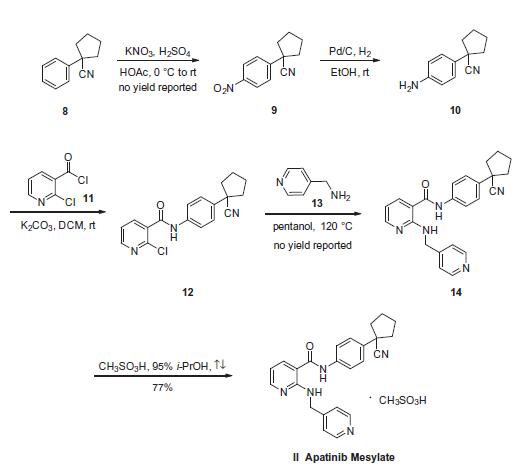Apatinib
|
|
|
- CAS-Nr.
- 811803-05-1
- Englisch Name:
- Apatinib
- Synonyma:
- CS-1160;Aptinib;Apatinib;Apatinib(b);Rivoceranib;Mesylate APA;Apatini Mesylate;Apatinib (YN968D1);Apatinib (Rivoceranib, YN968D1);APATINIB FREE BASE (YN968D1 FREE BASE)
- CBNumber:
- CB72561458
- Summenformel:
- C24H23N5O
- Molgewicht:
- 397.47
- MOL-Datei:
- 811803-05-1.mol
|
Apatinib Eigenschaften
- Siedepunkt:
- 578.2±50.0 °C(Predicted)
- Dichte
- 1.27
- storage temp.
- Store at -20°C
- L?slichkeit
- >49.4mg/ml in DMSO
- Aggregatzustand
- Powder
- pka
- 11.93±0.70(Predicted)
Sicherheit
- Risiko- und Sicherheitserkl?rung
- Gefahreninformationscode (GHS)
| Bildanzeige (GHS) |

|
| Alarmwort |
Warnung |
| Gefahrenhinweise |
| Code |
Gefahrenhinweise |
Gefahrenklasse |
Abteilung |
Alarmwort |
Symbol |
P-Code |
| H302 |
Gesundheitssch?dlich bei Verschlucken. |
Akute Toxizit?t oral |
Kategorie 4 |
Warnung |
![GHS hazard pictograms]() src="/GHS07.jpg" width="20" height="20" /> src="/GHS07.jpg" width="20" height="20" /> |
P264, P270, P301+P312, P330, P501 |
| H315 |
Verursacht Hautreizungen. |
Hautreizung |
Kategorie 2 |
Warnung |
![GHS hazard pictograms]() src="/GHS07.jpg" width="20" height="20" /> src="/GHS07.jpg" width="20" height="20" /> |
P264, P280, P302+P352, P321,P332+P313, P362 |
| H319 |
Verursacht schwere Augenreizung. |
Schwere Augenreizung |
Kategorie 2 |
Warnung |
![GHS hazard pictograms]() src="/GHS07.jpg" width="20" height="20" /> src="/GHS07.jpg" width="20" height="20" /> |
P264, P280, P305+P351+P338,P337+P313P |
| H335 |
Kann die Atemwege reizen. |
Spezifische Zielorgan-Toxizit?t (einmalige Exposition) |
Kategorie 3 (Atemwegsreizung) |
Warnung |
![GHS hazard pictograms]() src="/GHS07.jpg" width="20" height="20" /> src="/GHS07.jpg" width="20" height="20" /> |
|
|
| Sicherheit |
| P261 |
Einatmen von Staub vermeiden. |
| P264 |
Nach Gebrauch gründlich waschen. |
| P264 |
Nach Gebrauch gründlich waschen. |
| P270 |
Bei Gebrauch nicht essen, trinken oder rauchen. |
| P271 |
Nur im Freien oder in gut belüfteten R?umen verwenden. |
| P280 |
Schutzhandschuhe/Schutzkleidung/Augenschutz tragen. |
| P301+P312 |
BEI VERSCHLUCKEN: Bei Unwohlsein GIFTINFORMATIONSZENTRUM/Arzt/... (geeignete Stelle für medizinische Notfallversorgung vom Hersteller/Lieferanten anzugeben) anrufen. |
| P302+P352 |
BEI BERüHRUNG MIT DER HAUT: Mit viel Wasser/... (Hersteller kann, falls zweckm??ig, ein Reinigungsmittel angeben oder, wenn Wasser eindeutig ungeeignet ist, ein alternatives Mittel empfehlen) waschen. |
| P304+P340 |
BEI EINATMEN: Die Person an die frische Luft bringen und für ungehinderte Atmung sorgen. |
| P305+P351+P338 |
BEI KONTAKT MIT DEN AUGEN: Einige Minuten lang behutsam mit Wasser spülen. Eventuell vorhandene Kontaktlinsen nach M?glichkeit entfernen. Weiter spülen. |
| P321 |
Besondere Behandlung |
| P330 |
Mund ausspülen. |
| P332+P313 |
Bei Hautreizung: ?rztlichen Rat einholen/?rztliche Hilfe hinzuziehen. |
|
Apatinib Chemische Eigenschaften,Einsatz,Produktion Methoden
Beschreibung
Apatinib mesylate, discovered by Advenchen Laboratories (United
States of America, USA) and co-developed by Jiangsu Hengrui
Medicine Co. Ltd (China), was approved by the Chinese Food and
Drug Administration (CFDA) in October 2014 for the treatment of
metastatic gastric carcinoma. Apatinib mesylate is an oral tyrosine
kinase inhibitor that selectively inhibits the vascular
endothelial growth factor receptor 2 (VEGFR2), which prevents new blood vessel formation selectively in tumor tissue. Apatinib
has shown inhibition of the VEGF signaling pathway with an IC50
value of 1 nM for VEGFR-2 in in vitro enzyme experiments. A
multicenter phase II study of apatinib is underway with patients
in non-triple-negative metastatic breast cancer trials. Non-clinical
studies concluded that apatinib may reverse the ATP-binding
cassette subfamily B member 1 and subfamily G member 2
(ABCB1- and ABCG2, respectively)-mediated multidrug resistance
which allows cancer cells to circumvent certain conventional antineoplastic
drugs, suggesting that apatinib could be effective as a
combination therapy.
Verwenden
Apatinib (YN968D1) is a small-molecule selective multitargeted tyrosine kinase inhibitor with an IC50 of 2.43 nM for the inhibition of VEGFR2.
Synthese
The synthesis started
with commercially available 1-phenyl cyclopentane carbonitrile
(8), which was nitrated to provide nitrobenzene 9. Subsequent
reduction of 9 gave aniline 10, which was coupled with 2-chloronicotinoyl
chloride (11) to afford aryl amide 12. Subjection of the
2-pyridyl chloride within 12 to pyridin-4-ylmethanamine (13) in
hot pentanol gave 14. The preparation of apatinib 14 from starting
material 8 were reported on gram or milligram reaction scale with
no yield. 170 g of 14 was mixed with methylsulfonic acid in 95%
isopropanol¨CH2O solution to give 161.5 g of apatinib mesylate (II)
in 77% yield.

Apatinib Upstream-Materialien And Downstream Produkte
Upstream-Materialien
Downstream Produkte
- Apatinib
- Apatinib (YN968D1)
- Aptinib
- N-(4-(1-cyanocyclopentyl)phenyl)-2-(pyridin-4-ylMethylaMino)nicotinaMide
- Mesylate APA
- N-[4-(1-Cyanocyclopentyl)phenyl]-2-[(4-pyridinylmethyl)amino]-3-pyridinecarboxamide Apatinib
- 3-Pyridinecarboxamide, N-[4-(1-cyanocyclopentyl)phenyl]-2-[(4-pyridinylmethyl)amino]-
- CS-1160
- APATINIB FREE BASE (YN968D1 FREE BASE)
- Apatini Mesylate
- Apatinib (Rivoceranib, YN968D1)
- Apatinib(b)
- Rivoceranib
- 811803-05-1
- C25H27N5O4S
- Inhibitors

